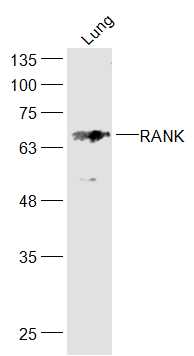RANK antibody
GTX10497
ApplicationsWestern Blot, ELISA
Product group Antibodies
ReactivityHuman, Mouse
TargetTNFRSF11A
Overview
- SupplierGeneTex
- Product NameRANK antibody
- Delivery Days Customer9
- ApplicationsWestern Blot, ELISA
- CertificationResearch Use Only
- ClonalityPolyclonal
- ConjugateUnconjugated
- Gene ID8792
- Target nameTNFRSF11A
- Target descriptionTNF receptor superfamily member 11a
- Target synonymsCD265, FEO, LOH18CR1, ODFR, OFE, OPTB7, OSTS, PDB2, RANK, TRANCE-R, TRANCER, tumor necrosis factor receptor superfamily member 11A, Paget disease of bone 2, TRANCE receptor, familial expansile osteolysis, loss of heterozygosity, 18, chromosomal region 1, osteoclast differentiation factor receptor, receptor activator of NF-KB, receptor activator of nuclear factor-kappa B, tumor necrosis factor receptor superfamily, member 11a, NFKB activator
- HostGoat
- IsotypeIgG
- Protein IDQ9Y6Q6
- Protein NameTumor necrosis factor receptor superfamily member 11A
- Scientific DescriptionRANK, receptor activator of NF-kappaB, also known as TRANCE receptor and osteoclast differentiation factor (ODFR), is a member of the tumor necrosis factor receptor (TNFR) family. The full-length mouse RANK cDNA encodes a type I transmembrane protein with an extracellular and a cytoplasmic domain. The extracellular domain contains two potential N-linked glycosylation sites. RANK shares significant amino acid homology with other members of the TNFR family in its extracellular four cysteine-rich repeats. Human and murine RANK share 81% amino acid identity in their extracellular domains. RANK is widely expressed, with highest levels in skeletal muscle, thymus, liver, colon, small intestine and adrenal gland. RANK is also expressed in dendritic cells. RANK (receptor activator of NF-kappaB) and RANK ligand (RANKL) are important regulators of interactions between T cells and dendritic cells. RANK is the essential signaling receptor for osteoclast differentiation factor in osteoclastogenesis. Multiple tumor necrosis factor receptor-associated factors (TRAFs) are involved in the signaling of RANK. TRANCE (TNF-related activation-induced cytokines, also known as RANK ligand, osteoprotegerin ligand and osteoclast differentiation factor) is the ligand for RANK. The biological functions mediated by RANK include activation of NF-kappaB and c-jun N-terminal kinase, enhancement of T cell growth and dendritic cell function, induction of osteoclastogenesis and lymph node organogenesis. The soluble form of RANK is able to block TRANCE induced biological activity. The binding of anti-RANK to cell surface RANK triggers signal transduction and induces RANK mediated bioactivity.
- ReactivityHuman, Mouse
- Storage Instruction-20°C or -80°C,2°C to 8°C
- UNSPSC12352203






